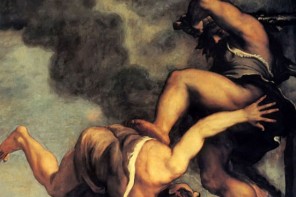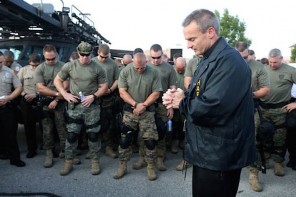On a beautiful early autumn afternoon, loosely organized groups of mostly young adults gathered in the shadow of the St. Louis Gateway Arch, symbol of a bygone vision of American progress, economic hope, and nascent global expansionism. Women wore shiny off-the-shoulder dresses and ridiculously high-heeled shoes. They sipped from splits of cheap sparkling wine while their tuxedoed companions swilled the local brew, Budweiser—that, too, a faded American icon, sold off in 2008 to the Belgium-based multinational, InBev.
No, of course, these were not the protesters who have begun to appear in more and more American cities, but keepers of the once-stable base of a certain version of the fabled American Dream: wedding parties. These were queuing up for photos on raised pedestals in the fountains in Kiener Plaza, the park in the shadow of the Arch.
Different as the decorated wedding groups seemed from the hundred or so other mostly young adults—OccupySTL—holding forth in Morton May Amphitheater across the way, it seems fair to say that their dreams were perhaps not so far apart from what historian James Truslow Adams was bold to name as a uniquely American aspiration even in the depth of the Great Depression:
…the American dream that has lured tens of millions of all nations to our shores in the past century has not been a dream merely of material plenty, though that has doubtless counted heavily. It has been much more than that. It has been a dream of being able to grow to fullest development as man and woman, unhampered by the barriers which had slowly been erected in older civilizations, unrepressed by social orders that developed for the benefit of classed rather than for the simple human being of any and every class.
Aspiration Meets Desperation
Mostly, members of the various wedding parties were unperplexed by the protesters offering testimony against an economic system that excludes far too many Americans from the fullness of even the most modest constructions of “domestic bliss.”
“That cat’s a f**king loser,” offered one groomsman by way of commentary, as Tom, a mechanic from East St. Louis, who declined to give his last name, talked about his inability to earn a living wage despite working 60 hours a week.
Aspiration meets desperation, and looks the other way.
Or, at least so it has usually been since the Reagan ascendency of the 1980s, with middle-class Americans curiously reorienting their dreams away from what might reasonably be attainable for pretty much everyone and toward a level of affluence available to ordinary people only through a freakish, high-stakes contortion of the economy.
Now that the curtain’s been pulled back on the false wizardry of a deregulated financial system, and Americans have been left holding a bag full of bank bailouts, home foreclosures, historic levels of unemployment and poverty, and wage stagnation for those with jobs, “loser” is a label most of us can, in one way or another, wear easily in the current economy. So goes the American Dream these days.
A New Light on the City on the Hill
It was an ironic (now almost cruel) turn in the American dreamscape when Ronald Reagan set a new American imaginary on a “shining city on a hill” that he remembered, with perhaps more glimmer than light, from the “Sermon on the Mount” of Matthew’s gospel. There, after the long inventory of blessings upon the poor, the hungry, and the peacemakers (which makes up the center of the Christian social justice tradition, the Beatitudes [Mt. 5:1-12]), Jesus says to the people,
You are the light of the world. A city on a hill cannot be hidden. Neither do people light a lamp and put it under a bowl. Instead they put it on its stand, and it gives light to everyone in the house. In the same way, let your light shine before all people, that they may see your good deeds and praise your Father in heaven.
Call it a biblical Sunshine Act, the city on the hill of Jesus’ imagining was not a glittering temple where the idols of unfettered market capitalism would shine across the globe. Rather, it was a peaceable kingdom of generosity, compassion, and neighbor-love to which people would find refuge from the long-hidden exploitations of a corrupted empire. “It gives light to everyone in the house”—along with health care, education, and a stable retirement. Kind of like Canada or Sweden, but with better weather.
The deregulatory spiral of the Greenspan years (through the Reagan, Bush Sr., Clinton, and G. W. Bush administrations) surely dimmed the lights on that dream, prompting, these last few weeks, protestors around the country to amend the beatific vision much as the later gospel writer, Luke (6:24-26), felt called to do:
But woe to you who are rich, for you have already received your comfort.
Woe to you who are well fed now, for you will go hungry.
Woe to you who laugh now, for you will mourn and weep.
Woe to you when everyone speaks well of you, for that is how their ancestors treated the false prophets.
This is at least one story that religion brings to the Occupy Together demonstrations across the country. Or, as Sarah Posner has pointed out twice this week, it could be if more people of faith—clergy and laypeople alike—supported the demonstrations with their presence, their resources, and their prayers in ways that embodied religious beliefs with regard to economic justice and social action.
Christianity adopts its approach to economic justice directly from the Jewish tradition laid out in the Torah and the Talmud. The Buddhist Pattakammavagga of the Anguttara Nikaya expounds four pleasures (having wealth, enjoying wealth, being debtless, being blameless) that are to be held in balance in order to attain happiness, the last of these meant to ensure that others might know contentment as well. Both in the Qur’an and in hadiths (sayings) attributed to the prophet Muhammad, care for those on the economic margins of society—not just the margins of Islam, but of the whole community—is central. These narratives of faith and wealth are the architectures of new dreams—not fantasies, but dreams—of an inclusive wholeness and a common stability.
Thus, in each of the world religions, advocating on behalf of those harmed by oppression, exploitation, illness, or other circumstances that leave ordinary people in the dust is a basic faith practice. We are meant, in the words of the Episcopal Book of Common Prayer, “to make no peace with oppression,” to “reverently use our freedom” in the service of justice.
“Justice for all,” as another line from the tattered American Dream goes. That’s what makes the “city on the hill” shine. That’s what, at the end of the day, offers hope for the resurrection not just of the American Dream, but of the American soul.




